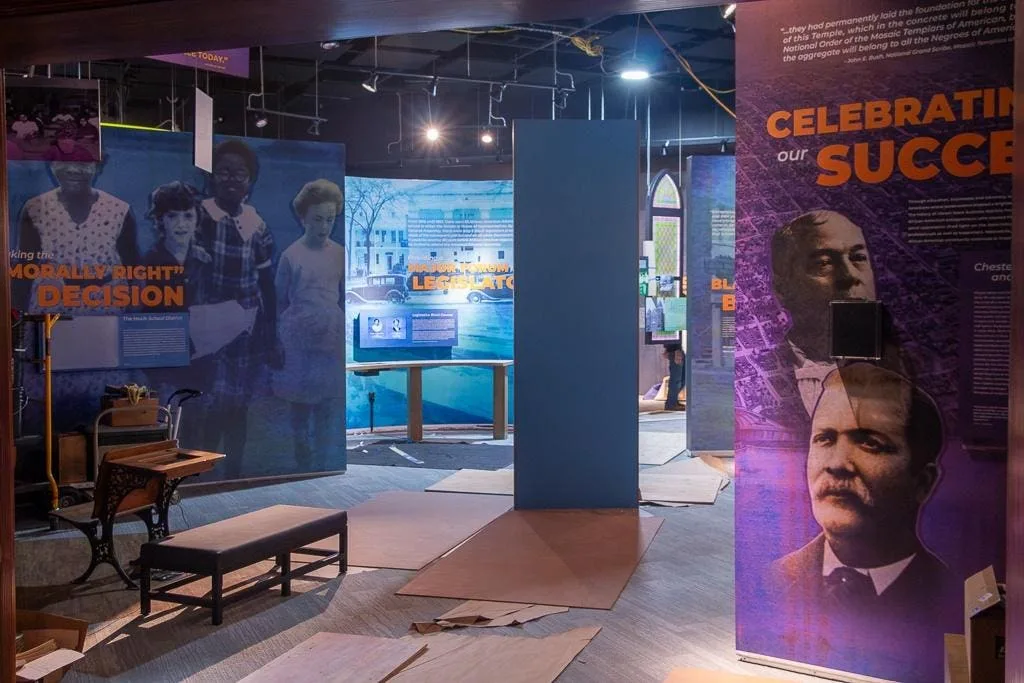
The heroism of the Little Rock Nine–nine teens who in 1957 placed their bodies in harm’s way integrating that city’s public schools in the face of a white mob of fellow students, racist police, the Ku Klux Klan, and state and local administrators stands, as a defining moment in American History, Civil Rights or otherwise. Theirs isn’t the only noteworthy story of Black history emanating from Arkansas.
The Elaine Race Massacre. Little Rock’s Ninth Street business district. Scipio Jones, Sue Cowen Williams, Daisy Bates and Mifflin Gibbs.
Sharing the full sweep of the African American experience in Arkansas is the mission at the Mosaic Templars Cultural Center in Little Rock which debuts a completely renovated permanent exhibition space on December 1, 2023. The Mosaic Templars of America themselves are a story worth knowing. The Black fraternal organization was founded in Little Rock in 1883.
“When people tend to think of Arkansas, they don’t think of all the achievements and the accomplishments,” Mosaic Templars Cultural Center Director Quantia Fletcher told Forbes.com. “They typically think of the Little Rock Nine and maybe Bill Clinton. The same stories of triumph and accomplishment and success and achievement that you see in Mississippi, that you see in Louisiana, that you see in Memphis are the same stories–same stories different people, different players–that are happening here in Arkansas.”
Following a $3.5 million upgrade, the new permanent exhibition space at Mosaic Templars highlights those players in ways the old setup could not.
“People want to go places and have experiences; whether it’s at the library or a concert or even sitting in their home watching TV, people want experiences, so (a museum presentation must be) more than just having the information on the wall and the artifacts behind the cases,” Fletcher said. “People want to feel immersed in the experience. (Visitors) want to feel like you’ve taken them on a journey. They want to feel like they are a part of the ride, that you’re bringing them along with you. That’s the thing that’s very different about the new space.”
The new space uses cutting edge technology in telling–and enlivening–age-old stories.
Artificial intelligence allows guests to converse with civil rights leaders. Talking mannequins share first person, oral history. Visitors hear gospel music and prayer. Historic Ninth Street is recaptured from when it was one of the most thriving Black business districts in the country.
With any luck, and thanks to the Mosaic Templars Cultural Center, it may one day be again.
Mosaic Templars Cultural Center
Mosaic Templars Cultural Center crest. (Photo by: Jeffrey Greenberg/Universal Images Group via Getty … [+]
The new museum space arrives at the intersection of two significant milestones for the building: the 140th anniversary of the incorporation of the Mosaic Templars of America and the Cultural Center’s 15th anniversary.
The Mosaic Templars Cultural Center is a faithful recreation of the original Mosaic Templars of America headquarters, erected in 1913, destroyed by fire during renovation efforts in 2005. A highlight on any visit is seeing a section of the original building’s façade immediately upon walking through the front doors.
In preserving, interpreting and celebrating African American history and culture in Arkansas, the center’s new permanent gallery reaches its arms out wide. Included are details related to the founders and history of the Mosaic Templars, Black businesses in Arkansas, Black legislators, and the state’s Historically Black Colleges and Universities. Religion, music–Sister Rosetta Tharpe and Al Green–and African American foodways are shared. African American contributions to agriculture and military service in the state.
The tragedy of the Wrightsville Boys Fire. Here’s guessing that atrocity will be unknown to most.
The renovated permanent exhibition space at Mosaic Templars Cultural Center in Little Rock, AR will … [+]
Chopping it up at the barbershop and beauty salon. The Cultural Center shares stories from the chair about how important these businesses were to their communities.
A surprising story in some cases.
“For a while, Arkansas was considered, dare I say, a progressive, a much more progressive area when you think about some of the movements that happened in Reconstruction,” Fletcher explained. “When the Black community was being built here in Little Rock, Blacks from all around the country were flocking to Little Rock because Little Rock was known to be a much more progressive area in terms of providing opportunity and work for African Americans after the Civil War.”
It wouldn’t always be that way.
Heroes and Sheroes
Civil Rights activist Daisy Bates signing autographs, Baltimore, Maryland, April 11, 1959. (Photo by … [+]
Visitors will learn about the Elaine Race Massacre where in 1919–the Red Summer–Black sharecroppers attending a meeting led by union organizers became involved in a shootout with white vigilantes attempting to disturb the gathering. The shootout escalated into an armed mob of hundreds–perhaps as many as a thousand–whites from the local and surrounding area descending upon the small town of Elaine to crush the supposed “insurrection” being staged by Black residents.
A posse of white citizens and federal troops detained hundreds Black citizens, more than 100 of whom were soon charged for their involvement in the violence with no meaningful investigation or evidence. Within five weeks of the first shots being fired, 12 Black men were tried, convicted, and sentenced to death for murder in the electric chair.
This is where Scipio Jones enters the story. Jones was the leading Black lawyer in Arkansas at the time and began fundraising and strategizing a defense for the Elaine Twelve. Over the next five years, at great risk to his personal safety, he fought for the men, eventually sparing them all from execution.
The case set important precedent for due process protections for African Americans.
Other heroes encountered at Mosaic Templars Cultural Center are Little Rock’s Mifflin Gibbes, the first elected African American municipal judge in the United States. Sue Cowan Williams, who challenged the Little Rock School System’s practice of paying Black teachers less than white colleagues based solely on skin color.
Daisy Bates’ mother was killed by white men when she was three years old. She went on to organize the Little Rock Nine and become the only female speaker at the 1963 March on Washington.
Despite that. Despite the Little Rock Nine, Arkansas is often overlooked as a destination for discovering the nation’s Civil Rights history.
“It’s something that I battle with every day,” Fletcher said. “People pass up Arkansas to learn about the boycott that happened with Dr. King in Memphis. They travel down to Louisiana where Plessy versus Ferguson happened, and they visit Mississippi with Medgar Evers and all these other amazing stories. You can’t separate that, all of those stories fit together as one.”
Same stories, different players, as Fletcher mentioned.
“There are 33,000 museums in our country and there’s probably another 10,000 we don’t even know about, there’s a museum for anything you want to do, however, people sometimes lump all Black museums or Black stories together,” Fletcher said. “Each state has its own story and Arkansas does too. I would hope that while some people may think, ‘I’ve seen one, I’ve seen them all,’ I like to think that Arkansas has a unique piece of the story about what it means to be Black in our country.”
The African American experience in America writ large took place in Arkansas. Black business districts and citizens thriving during Reconstruction only to be stamped down by a century of racial terror, Jim Crow segregation, and racist urban renewal. Legal and civil rights pioneers overcoming unthinkable obstacles to shape the nation. Religion, family and community keeping hope alive. Musicians, performers and athletes leaving indelible marks on the culture.
Visitors leave with the inevitable conclusion that Arkansas’ African American history proves inseparable from Arkansas history, from American history.
“While it is a Black history museum, it’s not a Black story, it’s a story of all Arkansas,” Fletcher said. “For me, it’s important to know, understand and realize that you can’t have one story without the other, and that they’re all interwoven, we learn that no matter who we are, all of our experiences are connected and important–the American experience, the Arkansas experience–not just the Black experience.”


